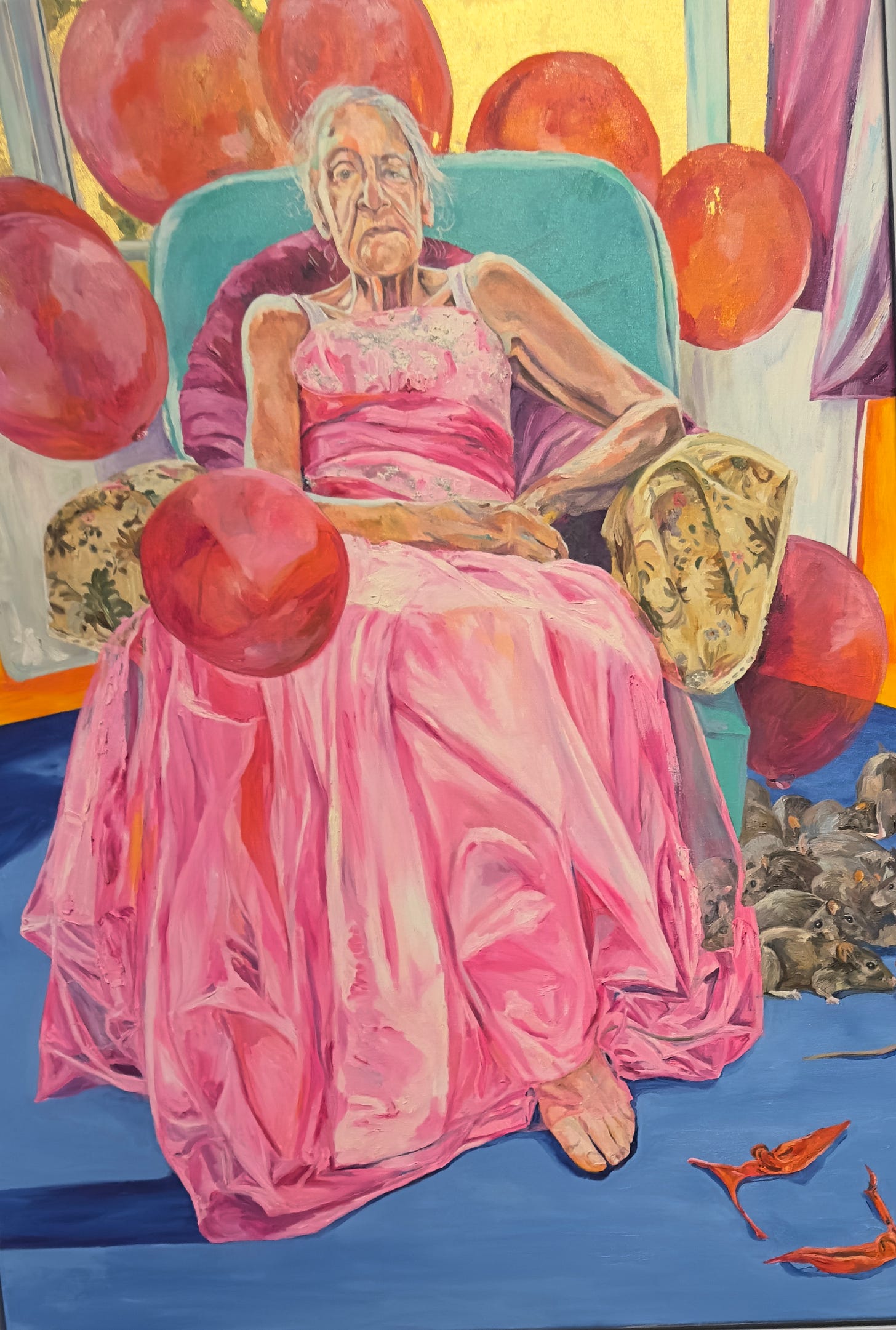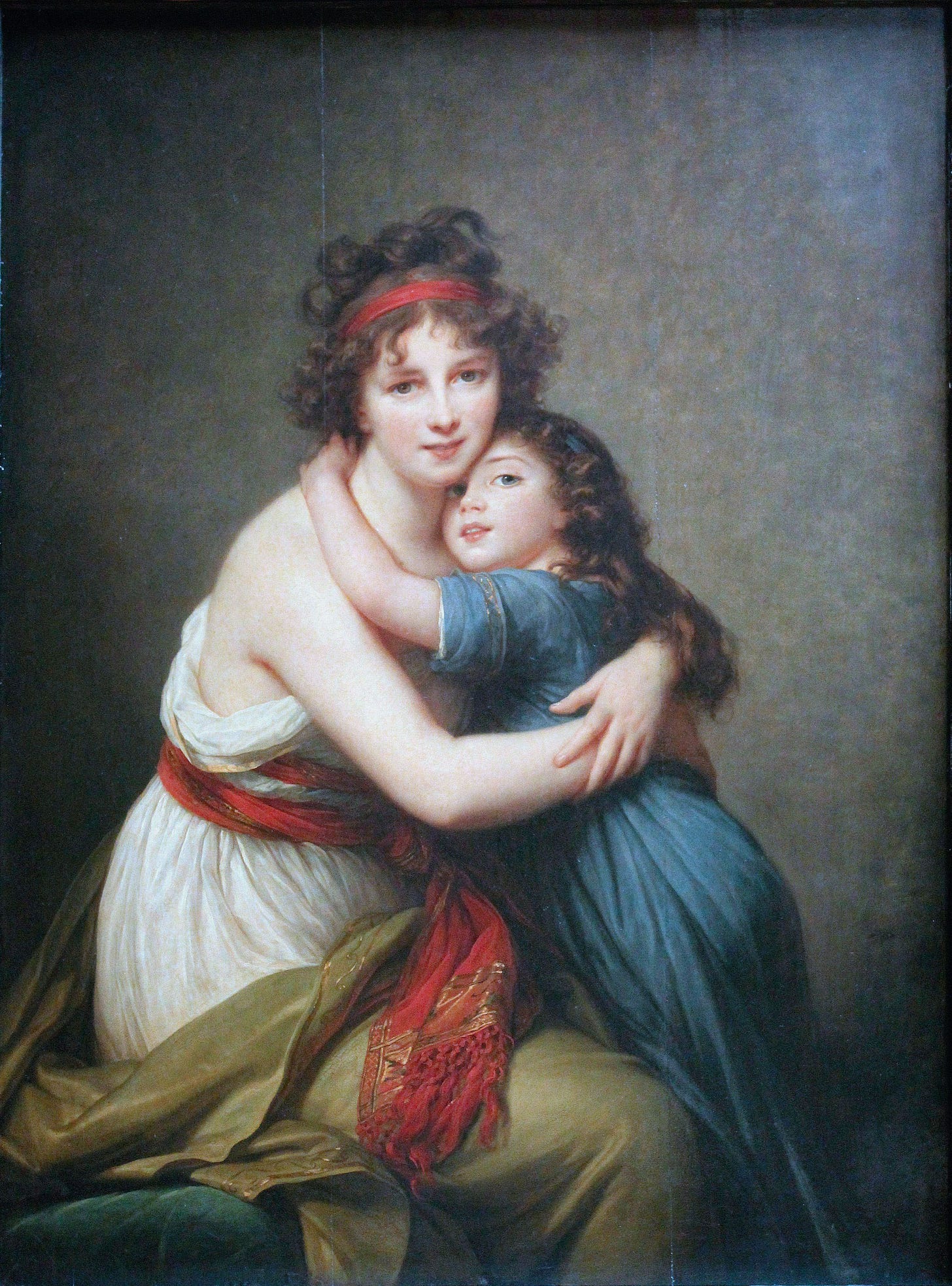ISSUE 9: The Frontline
A 21st century feminist publication where women's voices have power
Artist Christine Roychowdhury with ‘Tulip Fever’ the third of her portraits of her ailing mother
This week’s issue looks at how women have, down the centuries, used their creativity to explore issues that matter to them and other women, even when their work is vilified or misunderstood.
Virginia Woolf wrote in A Room of One’s Own, “Lock up your libraries if you like; but there is no gate, no lock, no bolt that you can set upon the freedom of my mind.” Our three women artists - a contemporary painter, a novelist and an 18th century French artist - are all women who have displayed courageous freedom of mind in pursuit of their art and the truth.
Novelist Polly Clark describes how her life was turned upside down when she revealed her gender-critical views, but she ends on a positive note after a successful appearance at this year’s Edinburgh International Book Festival. We were both in the audience at Polly’s event, where she discussed her work with fellow writer Abigail Dean, and we can testify that it was a wonderful, life-affirming hour. And Polly’s new novel Ocean is a must-read.
Artist Christine Roychowdhury tells of the devastating impact of her mother’s fading memory and how her inhumane treatment in hospital inspired a trio of compelling portraits. We are honoured to share all three with you. Sadly, Christine’s mother died only six weeks after she was released from hospital. In future issues, we will return to the subject of how society treats elderly women.
Our resident woman’s historian, Lily Craven, tells the fascinating story of French painter Élisabeth Vigée le Brun, whose work scandalised the Imperial court of Catherine the Great of Russia. Her crime? To paint women and girls with their bare arms on display.
Finally, the Policy and Power slot highlights the political party season which is well underway. It reminded us that it is 50 years since Margaret Thatcher was elected leader of the Conservative party and went on to become Britain’s first woman Prime Minister in 1979.
The button at the end of this issue takes you to our subscriber chat. As ever, you can also find us in real time on X/Twitter, at @DalgetySusan and @LucyHunterB and our shared account @EthelWrites.
We are delighted that we can now plan for our fortnightly 21st century feminist publication to remain fully accessible. But we depend on some of our readers becoming paid subscribers so that we can pay our contributors, as well as keep the newsletter free so ALL women can access it. If you can afford a paid subscription, please consider getting one. Thank you.
On stage in a cultural deep-freeze: Gender-critical writer Polly Clark recounts appearing at the 2025 Edinburgh International Book Festival
Polly Clark
This August I sallied onto the stage at the Edinburgh International Book Festival in my brand new high-heeled DMs, clutching my novel Ocean as if it were the last event I’d ever do. Who knows, it might be. But high stakes don’t intimidate me anymore. I’d not felt so exhilarated since I stood in a Siberian forest, during research for my novel Tiger, in front of a still-warm eviscerated boar, a striped predator somewhere nearby, and only a rag-tag trio of inebriated Russians with warped WW2 rifles to protect me.
I cut my literary teeth in the savage arenas of poetry, where performing well in front of an audience could mean the difference between selling books or being booed offstage, never to be seen again. I left my cushy publishing job in 2000 for poetry and never looked back. Give me a platform and I shine. But getting that platform has, for many women writers, become an impossible process.
As the technician fitted my microphone backstage, I exchanged smiles with my co-author, crime writer Abigail Dean. She seemed an innocent in the Siberian forest of my analogy. I longed for her straightforward path — but that, I now know, is not mine.
Only one of three “openly” gender-critical writers
I was one of only three openly gender-critical writers among nearly 700 at the Festival. The others were Chimamanda Ngozi Adichie and Judy Murray, which gives a sense of my rarity. But it wasn’t a glamorous kind. More like a rare earwig, or a bulbous, whiskery bottom-dwelling fish. If I died out, would anyone care?
Inside me boiled the sheer absurdity of it. I am not an activist; my public pronouncements have been limited to supporting JK Rowling, Graham Linehan, and women in court cases defending their rights. I am a fiction writer. A public position was forced upon me because, like so many women, the advance of gender ideology devastated my career and life.
In the immediate build-up to the Festival, a storm broke online and in the press about the exclusion of bestselling feminist books such as Women Who Wouldn’t Wheesht and Jenny Lindsay’s Hounded, as well as Unkind by Victoria Smith and Julie Bindel’s Lesbians: Where Are We Now? Meanwhile, transactivist writers were everywhere. Harry Josephine Giles had six events. The director, Jenny Niven, repeated the line that the debate was “toxic on both sides” and claimed to showcase only books that “moved the debate forward.” Ocean is not “about the issue,” but it is about how a woman remakes herself outside punitive gender roles. In Italy it is being embraced as a feminist novel. EIBF buried that allusion as deep as it could.
A disturbing turn of events
All my novels have been featured at EIBF. But between Tiger (2019) and Ocean came six years in which gender ideology ripped through institutions, the arts, and women’s lives. Under that pressure, my connections with fellow writers collapsed. To breathe, I opened a pseudonymous Twitter account as “Jean Rhys.” Eventually, last May, with the Cass Review shifting the ground, I dropped the mask. And this is where the backstory to my appearance at 2025’s EIBF takes a disturbing turn.
The tweet went viral and my world turned upside down. My literary agency held an emergency meeting. Complaints poured in. Friends unfollowed. I was being punished – but for what? Revealing my support for JK Rowling? I was devastated.
Amid the wreckage came an email from EIBF Director Jenny Niven inviting me to chair several events at 2024’s Festival. Surely she knew of my infamy, and if so, what a gesture! I accepted joyfully, but then silence fell. Weeks passed, then finally I was offered a different event without explanation. I suspected the truth and dug in. Six months of stonewalling followed until I finally obtained an email through a subject access request. An individual working within the Hachette publishing group had demanded my removal, claiming I would make authors “uncomfortable” and describing me as “vocally against trans rights.” False, defamatory, but decisive.
Vindicated but stunned, I carried on. I chaired Booker-winner Samantha Harvey and Lavinia Greenlaw in a standout event. I finished Ocean and took it to Eye Books, leaving my Big 5 publisher where the atmosphere was suffocating. The chill was real, but I refused to stop working.
My rightful place
So when I was told that Ocean would be programmed at EIBF this year, 2025, I was delighted but wary. Was I invited because I had to be? Because exposing last year’s attempted cancellation made it impossible not to? Was I there as token “balance”? And if so, did it matter? Writers need these moments. We need audiences, spaces, the chance to build our profile. I deserved to be there. Ocean deserved to be there. It broke my heart that no other feminist books were then programmed, and that EIBF doubled down on platforming those who had tried to cancel me. Yet still, I took my place on that stage.
And how did it go, this freighted event? It was magical. Feminists turned out in support, alongside crime readers drawn by Abigail Dean, and the ensuing conversation enraptured the audience. Though unacknowledged, there was unity in the room: people of all views, coming together for books.
There was no Jenny Niven, and no recognition of the price women authors continue to pay simply for trying to speak. But the readers came, ideas were exchanged, and I left on a happy high — having found extraordinary sisterhood and avoided, metaphorically, the fate of that Siberian boar. In this cultural deep-freeze, that counts as a win.
Polly Clark is the prize-winning author of four poetry collections and three novels, the latest of which is Ocean. Born in Canada, she was brought up in the north of England and Scotland, and now divides her time between the West of Scotland and a houseboat in London. Her work has been shortlisted for the Saltire Scottish Book of the Year and the TS Eliot Prize. She publishes essays and novel serialisations weekly on her substack Monday Night Reads.
POLLY’S LATEST NOVEL IS AVAILABLE NOW
Ocean, described by Louis de Bernieres as “Strange, wonderful and compelling” is out now in hardback and e-book from Eye Books. Signed copies available direct: https://www.eye-books.com/books/ocean
Who will speak out for you? In a series of powerful portraits, an artist captures her mother’s growing frailty and the health system’s failure to care for her in hospital
By Christine Roychowdhury
I am Lost
My art is generally about things that catch my notice, fascinate me or otherwise annoy me. I look to capture the universal in the particular. The painting of my mother in the pink dress, ‘I am Lost’, came about in a convoluted way.
I had just decided to become a full-time artist after years of juggling my art career with my work career and I had moved back from Scotland to Suffolk. My studio was set up and my easel poised for work, when my mother, who lived in Wigan, said she was lonely. I had always been close to my mother and regarded her as the rock upon which I had built my life. I phoned her each and every day. My first thought was “Oh, fuck” and I tried to ignore it, hoping it would go away.
My mother’s memory began to fade
It soon became apparent, however, that this was a symptom of her mind losing its focus and her memory going. She was forgetting that someone had visited just the day before or had phoned, so in her mind she was on her own. Like a paper bag with a hole, the rats had got in.
Trouble brewed. No one heard from her for days. She stopped answering the phone. Neighbours and relatives were called and the police sent around. Things began to escalate.
I decided that my mother would move in with us. How can you say that you love someone so much and yet do nothing when they need you?
She moved into my studio and we shared it rather like hot bedding - there were good days and awful days. She saw the painting of ‘I am Lost’ as it progressed, even smudging it in the night as she got used to the fact she should sleep at night and wake during the day. It was a rocky start! She didn’t notice the rats [on the canvas] and as my mother always played along with my ideas, I hesitated at the cruelty of the intrusion.
My mother lived with me for two years and one day her delirium increased so much the doctor decided to admit her to hospital for treatment. This was where the ‘normalised’ treatment of ‘the elderly’ kicked in and my anger at ‘their’ treatment made the painting ‘Hospitalised’ a must.
My anger and frustration grew as my mother faded in hospital
When I entered the ward after she was admitted, a carer was feeding my mother with a spoon as she lay in bed. I questioned this, as only that morning she had sat at the table and eaten breakfast unaided. The next day my mother was shouting and a patient on the ward told me she had been shouting all day, asking to be taken to the toilet. I put this down to a symptom of the delirium, thinking they couldn’t possibly not be taking her to the toilet - she must be forgetting that they had. I thought, “Oh God, she’s turned into one of those shouting patients”.
I spoke to the nurse on the duty station and she said, “Oh, isn’t she wearing pads?” and said they would arrange for her to get up the next day. I explained she wasn’t incontinent and that she was up every day.
Little did I realise that this was the beginning of an ongoing saga where each day they would say they would get her up and then did not. The physio said she wasn’t able to get up. The occupational therapist said she wasn’t able to get up and that my mother didn’t make the least effort to roll over and get up.
I patiently explained that this was the part she needed help with and that she had got up every day of her 92 years. But as the weeks went by, the saga continued.
They lost her hearing aids multiple times and didn’t feel it was important enough to her wellbeing to find them. They told me they were “safely in the cupboard” or that she could “hear without them”. Etc, etc.
Slowly, I lost patience. My mother lost her mobility, a stone-and-a-half in weight and hope. They gave her paracetamol to mask the pain in her legs as her muscles wasted. Her shouting stopped and she began to shut down. She lay on her bed, her one seeing eye face down on the pillow. The painting ‘Hospitalised ‘ is born in anger and frustration, a plea for change.
Hospitalised
The duty nurse told me I needed to get her out of hospital and off the treatment pathway or she would die, so I started the fight to get her home. I hadn’t thought that I would need to fight to get her out, but they had decided she should be in a care home. I explained she lived with me and that I didn’t want her to go into a care home and that she had never wanted to go in one either. That was when they asked me if I had Power Of Attorney.
I had to take her home
At that point I agreed to anything they said to get my mother home. The system had got her and I needed to get her out.
I produced these three portraits of my mother at this time. The first, ‘I am Lost’, was at the beginning of the journey where we were just realising that the rats had got in and that my mother’s memories were being burst like balloons.
The second is ‘Hospitalised’. And the third, ‘Tulip Fever’, shows her as she was brought home on a cold November day wrapped in her hospital sheets, her feet bare. It is painted as a vanitas - a genre of still life painting - as a reminder of what is really important in life.
I would not feel so bad if this was just my personal experience, but everywhere I go I meet people who say, “yes it happened to my mother too.” It’s not just a natural degeneration, it’s the lack of respect, the lack of dignity in the treatment of the elderly, their treatments as ‘them’ or an ‘other’. As they say, if you don’t care enough to speak out, who will speak out for you?
Christine Roychowdhury was born in Lancashire into a working-class family. She studied Fine Art at Goldsmith’s College in the 1980s, which greatly influenced her belief that art should work on a both visual and intellectual basis as well as an emotional one. She produces large scale work, mainly in oil on canvas.
Her work tackles subjects that are not normally regarded as important and have slipped through the cracks of history which was predominantly dominated by men. She explores the relationship between mothers and daughters, both as a power struggle and as a support for each other.
She has exhibited in several galleries, including the Manchester City Gallery, Salford Gallery and Aberdeen Art Gallery. She exhibited in the Scottish Portrait Awards 2018/19 and 2020/21 and the Scottish Royal Academy in 2022. She has been shortlisted for several exhibitions and awards, including the BP Portrait Exhibition and the Theo Paphitus Art Prize.
She was elected a member of the Society of Women Artists in 2025.
Atta girl! The ‘scandal’ of the female artist who shocked European society by daring to paint women and girls with their bare arms on display and showing their teeth when they smiled
By Lily Craven, known to her many fans on Twitter/X as @TheAttagirls
Self-portrait with Her Daughter by Elisabeth-Louise Vigée Le Brun. Image via Wikimedia Commons
Woman of the Week artist Élisabeth Vigée le Brun of Paris (1755-1842) painted over 600 portraits of women and girls, but one of two little sisters and another of herself with her little daughter - charming works that would grace any art gallery - were considered quite shocking by the standards of the day. Scandalous, in fact.
Even as a girl at the convent school which she had attended from the age of six, her natural artistic talent got her into trouble. Instead of concentrating on her lessons, she drew.
She wrote: “During that time, I scrawled on everything at all seasons. My copybooks, and even my schoolmates’, I decorated with marginal drawings of heads, some full-face, others in profile; on the walls of the dormitory, I drew faces and landscapes with coloured chalks. So, it may easily be imagined how often I was condemned to bread and water. I made use of my leisure moments outdoors in tracing any figures on the ground that happened to come into my head.”
A natural talent
Her painter father was jubilant. “You will be a painter, my child, if there ever was one”, he said, and began instructing her. He died when she was 12. Grief overwhelmed her, but she eventually returned to drawing as a coping mechanism, and at the age of 15, opened her own studio where she painted portraits professionally.
Élisabeth’s work was popular, especially with wealthy and well-connected people, but in 1774, her studio was shut down by the authorities for operating without a licence. She quickly joined the Académie de St Luc - very few women were admitted then - and by the age of 20, she was established at court.
In January 1776, she married. It was a mistake. He was an art dealer, a fact that stopped her from being admitted to the prestigious Académie Royale de Peinture et de Sculpture, France’s answer to the Royal Academy, and he was a philanderer and gambler to boot. People tried to warn her, but it took some years before she could bring herself to acknowledge that they were right, and by then he had left her finances in a mess. She wrote: “In 1789, when I quitted France, I had not an income of twenty francs, although I had earned more than a million. He had squandered it all.”
Nonetheless, in 1779, Élisabeth acquired a royal patron, Marie-Antoinette, for whom she painted over 30 portraits. The Queen interceded with the Académie Royale with the result that, four years later, it grudgingly admitted Élisabeth as one of the four women permitted by its annual quota. Royal patronage was a mixed blessing. Inevitably, her association with the Queen led to her flight to Italy from France in 1789.
Fleeing the chaos of the French Revolution
She later recalled: “Society seemed to be in a state of complete chaos, and honest people were left to fend for themselves, for the National Guard was made up of a strange crew, a mixture of bizarre and even frightening types. Everyone seemed to be suffering from fear. I grieved for the pregnant women who passed, the faces of most of them were sallow with worry. I noticed that the generation born during the Revolution was, in general, a lot less healthy than the previous one; indeed, most of the children born in this sad time were weak and suffering!”
She toured Europe instead, and found herself and her work welcomed by European nobility and royalty. In all, Élisabeth created 660 portraits and 200 landscapes.
So why did those paintings shock sensibilities?
Élisabeth’s original portrait of Catherine the Great’s granddaughters showed the girls with - prepare yourself! - bare arms and earned the Imperial ire. She had to paint sleeves in. Later, a courtier tried to smooth things over, telling her it was a joke, but too late. Damage done.
As for the self-portrait with her little daughter Jeanne, known as Julie, it was Élisabeth’s smile that was so scandalous. It showed her teeth. Mémoires Secrets, a sort of tabloid circulating in France from 1762 to 1787, proclaimed: “An affectation which artists, art-lovers and persons of taste have been united in condemning, and which finds no precedent among the Ancients, is that in smiling, she shows her teeth”. Even Simone de Beauvoir had a dig more recently, criticising her “smiling maternity” and “frivolous” choice of subjects.
I am pleased to tell you that Élisabeth took no notice. She painted several more, including another self portrait, with open smiles.
In her misspent youth, Lily Craven spent 28 years in prisons in England writing risk assessments, operational orders and contingency plans. Now retired, she spends her time finding ordinary women whose extraordinary achievements were buried in dusty footnotes in history books and writes about those instead.
Navigate the public policy maze with the editors as they keep a watching eye on the issues affecting women
Pic by: akinbostanci via iStock
We are all busy, so it is hard to keep up with what people in power are up to - particularly in relation to policies and services that affect women and girls. We can’t offer a full monitoring service but each edition we will highlight a few things to watch out for, and where you can find more information.
It’s autumn so it must be party conference time
It is conference season for the main political parties. The Liberal Democrats held theirs last week in Bournemouth, where delegates rejected a move by the campaign group Liberal Voice for Women (LVW) to remove trans-identified men from gender diversity quotas.
Liberal Democrat leader Ed Davey later told the BBC’s Laura Kuenssberg that he was “sorry if they’re [LVW] cross but I do think the truth is what I’m saying, is that we abide by the law.” Earlier this week, it was revealed that the party was consulting lawyers to check if its constitution complies with the Equality Act. Watch this space.
The Labour Party’s annual event kicks off in Liverpool this Sunday 28th September. Labour Women’s Declaration (LWD) is hosting a Fringe event on Sunday afternoon to reflect on the Supreme Court ruling and other milestones in the campaign to protect women’s rights. It will be available to watch on LWD’s YouTube channel. Speakers include Susan Smith of For Women Scotland and Tracy Gilbert, Labour MP for Edinburgh North and Leith.
The Conservative Party heads to Manchester for its 2025 conference which runs from Sunday 5th to Wednesday 8th October. You can monitor proceedings on X (formerly Twitter) at @cwowomen and @Conservatives.
Vote now for Women in Westminster: The 100
Nominations are now open for this annual list of the top 100 women who have made a significant and lasting impact across the Westminster landscape in the last year.
Women selected for Women in Westminster: The 100 may include – but are not limited to – parliamentarians, journalists, civil servants, campaigners, think tankers and public affairs professionals.
Find out more here.
Westminster, the ‘mother’ of parliaments. Pic by: sborisov via iStock
The UK Parliament is enjoying its annual Conference recess until 13th October, but the rest of the UK’s legislatures are back from their summer break.
Northern Irish Assembly (click on “View full agenda” for the detailed forward look)
Scottish Parliament (click on “Read today’s Business Bulletin”)
Senedd Cymru | Welsh Parliament (click on “View full calendar”)

















